Source: 0xGreythorn
Project name: Saga
Project type: L1
Stock code: $SAGA
Cryptocurrency ranking: 221
Market capitalization: $22.5M
Fully diluted value (FDV): $3.6B
Circulating supply: 90M (9%)
Total supply: 1B
Maximum supply: ∞
Introduction
Modular blockchain provides solutions to the difficulties of achieving decentralization, security and scalability in blockchain technology. This innovative approach distributes the basic functions of blockchain, such as execution, settlement, data availability and consensus, across specialized networks. Unlike traditional blockchains that rely on a single network to handle all operations, modular blockchains separate these tasks, significantly increasing the efficiency of each function.
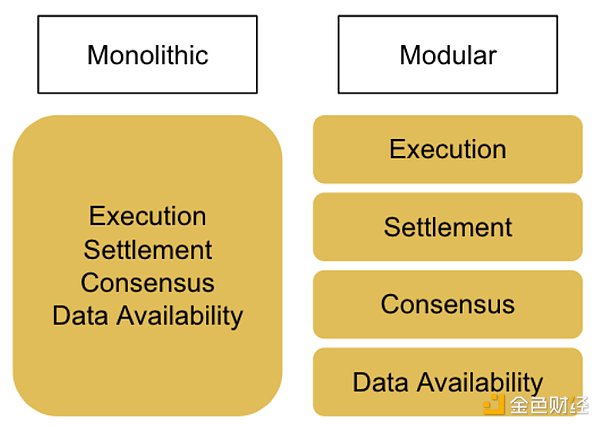
Source: Binance Research
Modularization is the key to improving blockchain scalability A promising path that solves the key issues of decentralization and security that many blockchain projects are actively exploring and developing. Since the inception of Celestia, the modular field has seen the development of various solutions such as shared sequencers, verification systems, interoperability protocols, order flow abstraction projects, and projects like rollup framework and Rollup-as-a-Service (RaaS). infrastructure provider.
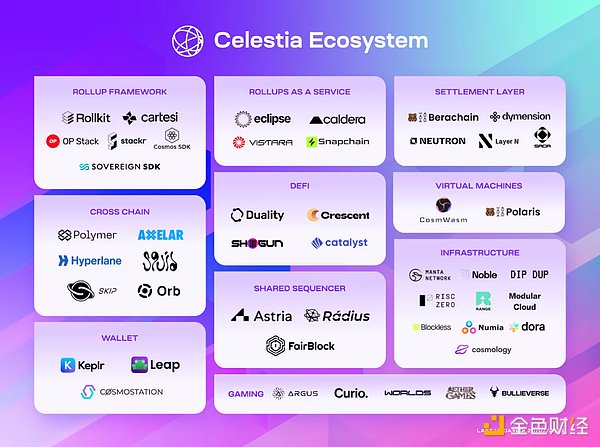
Source: Celestia
One noteworthy project is Saga, which is a A modular Layer 1 platform tailored for the gaming industry, it has recently emerged as an innovative player in the crypto space.
Saga Overview
Launching a blockchain can be complex as it requires developers Handles various technical aspects of blockchain infrastructure. The Saga Protocol simplifies this process by providing Chainlet, a purpose-built blockchain that developers can launch as easily as deploying smart contracts. This solution integrates key elements such as data availability, consensus, execution and settlement to create a seamless product experience. By integrating these components, Saga not only saves developers time but also reduces the complexity typical of module systems.
The Saga protocol runs on a fully decentralized proof-of-stake model, ensuring that each Chainlet maintains the same high security standards as the Saga mainnet and uses Same set of validators.
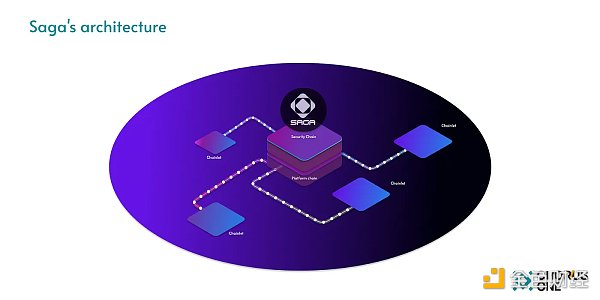
Saga's influence is evident in its rapid growth. In less than two years, it has successfully attracted 350 projects, 80% of which are focused on the gaming industry. Strategic partnerships with industry leaders such as Polygon, Avalanche, and Celestia further highlight Saga’s ability to effectively scale infrastructure and support a wide range of blockchain applications.
Saga Architecture
Chainlets
Saga Protocol is revolutionizing the way blockchain is deployed through its product Chainlets. These are automated, high-performance blockchains that are interoperable and customizable within the Saga ecosystem.
These Chainlets are protected by the Saga blockchain and verified through a shared security model called "Interchain Security", enjoying solid Protect. This model enables Saga to provide security for its Chainlets, ensuring they have the same level of security and decentralization as Saga itself, functioning similarly to the Cosmos SDK application chain, but without the need to manage a validator set itself.
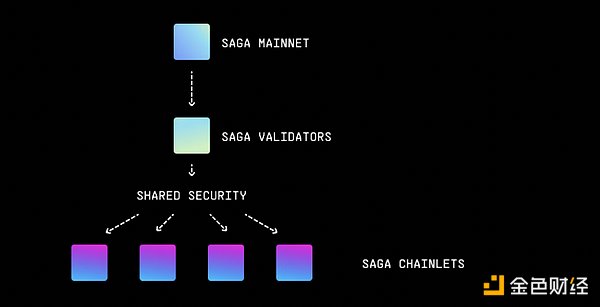
Source: Saga
Chainlets provide developers with a decentralized and A secure way to deploy application-specific blockchains, allowing developers the freedom to choose their preferred virtual machines. This flexibility was highlighted at the Saga Multiverse Summit with the launch of Saga Realms, which enables developers to launch customizable chains on Saga with different features and services, such as technology stacks, security sources and their associated obligations. Under the Realms framework, the standard Saga Chainlet will become one of many areas supported in the future, including providing services for Saga's partners Ethereum (Ethlets), Polygon, Avalanche, Celestia, etc.
Compared with the replication security mechanism adopted by Cosmos Hub, the process of starting a Chainlet is unique and permissionless. Developers simply pay for setting up and maintaining their Chainlet using $SAGA tokens, which is similar to using a subscription service from a provider like Amazon Web Services, but with payments in $SAGA tokens.
Security chain
The security chain is the main source of security for the Saga protocol, using Cosmos-SDK . It is responsible for the minting, staking of $SAGA tokens and potential penalties for validator misconduct.
Platform chain
The platform chain is also built based on Cosmos-SDK and is a platform for developers to initiate and A place to manage its Chainlets. It brings together multiple security sources, including Security Chain, and extends security to Chainlets through a process called Cross-Chain Verification (CCV), while notifying any reported misconduct back to Security Chain for potential punitive action.
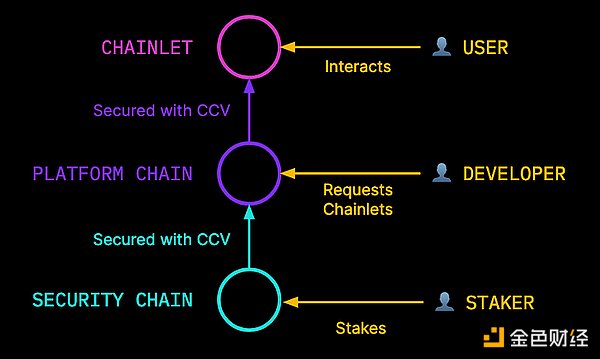
Initially, the platform chain will primarily obtain security from the Saga security chain, but plans to include additional security sources including Ethereum, Polygon, Avalanche and other validators in the future .
Team, Adoption and Alliance
The Saga team consists of a group of dynamic and experienced Co-founder leadership:
Jin Kwon, co-founder and chief executive officer Strategy officer, former vice president of Ignite, holds a master's degree in computer science from the University of California, Berkeley.
Jacob McDorman, co-founder and chief technology officer, once co-founded a software consulting company Cellaflora holds a bachelor's degree in mathematics from Purdue University.
Bogdan Alexandrescu, a technical expert and entrepreneur, active in the Bitcoin Foundation and many A blockchain project.
Rebecca Liao, co-founder and CEO, and head of global trade blockchain Skuchain Co-founder. Under her leadership, Skuchain’s annual transaction volume exceeded US$5 billion and was named a top blockchain company by the World Trade Organization in 2020.

As of April 26, 2024, the Saga Innovator Program contains 350 projects, 80% of which focus on the gaming field. 10% focuses on NFT and entertainment, and the remaining 10% focuses on decentralized finance (DeFi). These projects leverage Saga’s technology to innovate and expand its blockchain applications.
Saga has partnered with several leading blockchain protocols to scale with its Chainlets technology:
XPLA and Com2uS: In November 2022, Saga partnered with XPLA to provide scalable infrastructure for game-specific chains.
Celestia Lab: In January 2023, Saga began to implement the sequencer as a service, working with Celestia to expand the convolutional architecture.
Polygon: In February 2023, collaborate on an automated super network to promote the deployment of application chain solutions.
Avalanche: In April 2023, the instantiation of the Saga automation subnet enhanced the deployment of the application chain.
Saga Origins will be launched in March 2024 and is committed to leading Web3 games into the market. This department actively supports game developers at every stage from initial concept to final release. To facilitate success, Saga Origins offers a range of services including working with influencers to increase visibility, providing financial support for user acquisition, and extensive promotional support to maximize impact and engagement.
Token Economics
$SAGA tokens have multiple uses in the Saga protocol. It is the currency used by developers to pay network validators when launching and maintaining Chainlets. It is also a way to reward users who stake their tokens to support the security of the network. In addition, holding $SAGA also gives users the right to vote on future decisions of the network. Initially, one billion $SAGA tokens will be issued, of which approximately 90 million, or 9%, will be released at the token generation event.
The market capitalization is US$22.5 million, and the fully diluted value is US$3.6 billion. There are currently 90 million tokens in circulation, accounting for 9% of the total supply of 1 billion.
Token distribution:

Source: Cryptorank
Token issuance plan:

Source: Binance Research
Financing history
In October 2021, the company successfully raised US$2 million with investment from Ignite. The following year, on May 19, 2022, it successfully raised an additional $6.5 million in a seed funding round from investors including Hypersphere Ventures, Maven 11 Capital, SamsungNext, Merit Circle, Polygon Studios, and LongHash Ventures. On November 20, 2023, it raised another $5 million in an extended seed round, led by Placeholder Ventures and supported by LongHash Ventures, Com2uS, Red Beard Ventures, Dispersion Capital, and Tykhe Block Ventures.
In addition to these successful funding rounds, Saga’s landmark listing on Binance surpassed all previous launch pool records for the platform, attracting in less than 24 hours raised more than $13 billion.
Positive fundamental factors
The criticality of modularity: Modularity is the key to solving the scalability, decentralization, and security challenges in blockchain technology. As an early adopter of this model, Saga will benefit greatly once this model becomes widely accepted.
The rise of the game finance industry: Game Finance (GameFi) has become one of the most promising industries in the field of digital assets, Saga Significant resources are being invested in this area to ensure it has a prominent position in the industry.
Strategic partnerships: Saga has established strategic partnerships with important blockchain entities such as Polygon, Avalanche and Celestia. These partnerships The relationship strengthens Saga’s technology infrastructure and broadens its ecosystem, enhancing its ability to support scalable and efficient blockchain applications.
Securing significant investment: Saga has received significant investment from reputable investors, providing the necessary financial stability to support its continued development and expansion. Saga’s record launch on Binance highlights its market credibility and potential for success, which has been supported by widespread community engagement and unwavering investor confidence.
Negative fundamental factors
- < p style="text-align: left;">Fierce market competition: The blockchain field, especially the gaming and decentralized finance (DeFi) markets, is highly competitive, with many established competitors and emerging new entrants. enterprise. Saga’s success relies on its continued ability to innovate and its differentiation from other blockchain platforms in improving scalability and efficiency.
High market volatility: From an investment perspective, the cryptocurrency market is extremely volatile and has a negative impact on macroeconomic factors, liquidity cycles and economic news. Very sensitive. Despite the high potential of the technology and Saga, the speculative nature of the market often obscures its actual use and demand.
Regulatory and legal risks: Regulatory changes or legal developments adverse to cryptocurrencies may affect Saga's operations, particularly in relation to its Key markets where growth is critical.
Conclusion
With the evolution of blockchain As a notable player in modular blockchain technology, especially in the gaming space, Saga enhances efficiency, security and scalability by dividing different blockchain functions into specialized networks. The importance is particularly prominent. The introduction of Chainlets and its commitment to scalable, interoperable and cost-effective infrastructure positions Saga not only to meet the current demand for blockchain solutions, but also to profoundly impact the future development of decentralized applications. Saga’s commitment to progress and innovation marks it as a key and noteworthy entity in the blockchain ecosystem.
 JinseFinance
JinseFinance










